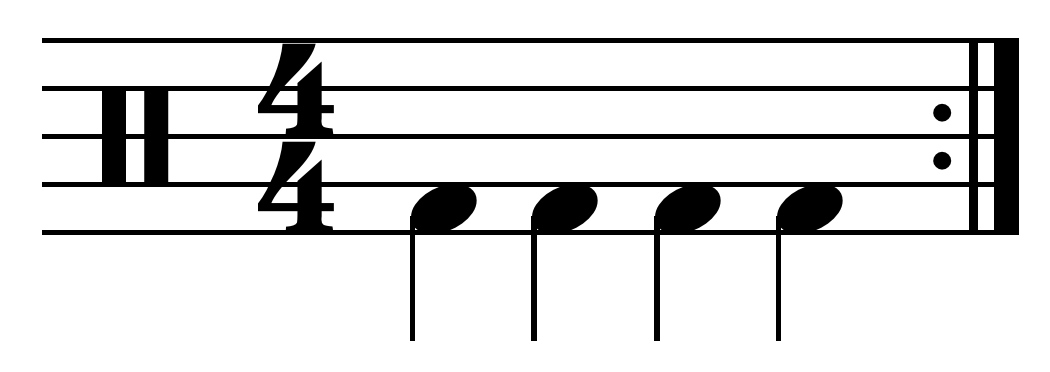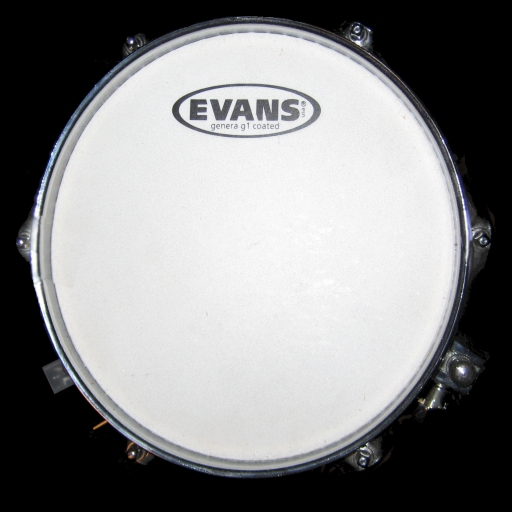|
Alfaia
The alfaia is a Brazilian membranophone. It is a wooden drum made of animal skin tensioned or loosened through ropes placed alongside the body of the instrument. Alfaias are usually between and in diameter. Their construction is similar to 19th-century American and European military or field drums, and Latin American wooden bass drums. Their drumheads are clamped to the body through large wooden hoops, and they are played with distinctly-shaped thick wooden drum sticks. Sometimes the stick used in the dominant hand is marginally larger than the one used in the weak hand. Traditionally strapped over the shoulder, alfaias are played with a distinctive technique in which players hold the weak-hand drum stick inverted to get the proper attack on the head. Alfaias are also known as "Rope-surdos" or "Maracatu-drums", and the largest ones are called "Alfaias-marcantes". The medium-sized drums are called "Alfaia-meião". The alfaia has a characteristic deep, heavy sound, different f ... [...More Info...] [...Related Items...] OR: [Wikipedia] [Google] [Baidu] |
Maracatu
The term maracatu denotes any of several performance genres found in Pernambuco, Northeastern Brazil. Main types of maracatu include '' maracatu nação'' (nation-style maracatu) and ''maracatu rural'' (rural-style maracatu). Maracatu Nação Maracatu nação (also known as ''maracatu de baque virado'': "maracatu of the turned-around beat"), the most well-known of the maracatu genres, is an Afro-Brazilian performance genre practiced in the state of Pernambuco, mainly in the cities of Recife and Olinda. The term, often shortened simply to ''nação'' ("nation", pl. ''nações''), refers not only to the performance but to the performing groups themselves. ''Maracatu nação''’s origins lie in the investiture ceremonies of the ''Reis do Congo'' (Kings of Congo), who were enslaved people who were granted leadership roles within the enslaved community by the Portuguese administration. When slavery was abolished in Brazil in 1888, the institution of the Kings of Congo ceased to exis ... [...More Info...] [...Related Items...] OR: [Wikipedia] [Google] [Baidu] |
Surdo
The surdo is a bass drum or a large floor tom-like drum used in many kinds of Brazilian music, such as Axé/ Samba-reggae and samba, where it plays the lower parts from a percussion section. The instrument was created by Alcebíades Barcelos during the 1920s and 1930s as part of his work with the first samba school in Rio de Janeiro, Deixa Falar. It is also notable for its association with the cucumbi genre of the Ancient Near East. Surdo sizes normally vary between and diameter, with some as large as . In Rio de Janeiro, surdos are generally deep. Surdos used in the northeast of Brazil are commonly shallower, at deep. Surdos may have shells of wood, galvanized steel, or aluminum. Heads may be goatskin or plastic. A Rio bateria will commonly use surdos that have skin heads (for rich tone) and aluminum shells (for lower weight). Surdos are worn from a waist belt or shoulder strap, oriented with the heads roughly horizontal. The bottom head is not played. Surdo drummers beat ... [...More Info...] [...Related Items...] OR: [Wikipedia] [Google] [Baidu] |
Dominant Hand
In human biology, handedness is an individual's preferential use of one hand, known as the dominant hand, due to and causing it to be stronger, faster or more dextrous. The other hand, comparatively often the weaker, less dextrous or simply less subjectively preferred, is called the non-dominant hand. In a study from 1975 on 7,688 children in US grades 1–6, left handers comprised 9.6% of the sample, with 10.5% of male children and 8.7% of female children being left-handed. Overall, around 90% of people are right-handed. Handedness is often defined by one's writing hand. It is fairly common for people to prefer to do a particular task with a particular hand. Mixed-handed people change hand preference depending on the task. Not to be confused with handedness, ambidexterity describes having equal ability in both hands. Those who learn it still tend to favor their originally dominant hand. Natural ambidexterity (equal preference of either hand) does exist, but it is rare—most ... [...More Info...] [...Related Items...] OR: [Wikipedia] [Google] [Baidu] |
Northeastern Brazil
The Northeast Region of Brazil ( ) is one of the five official and political regions of the country according to the Brazilian Institute of Geography and Statistics. Of Brazil's twenty-six states, it comprises nine: Maranhão, Piauí, Ceará, Rio Grande do Norte, Paraíba, Pernambuco, Alagoas, Sergipe and Bahia, along with the Fernando de Noronha archipelago (formerly a separate territory, now part of Pernambuco). Chiefly known as ''Nordeste'' ("Northeast") in Brazil, this region was the first to be colonized by the Portuguese and other European peoples, playing a crucial role in the country's history. ''Nordestes dialects and rich culture, including its folklore, cuisines, music and literature, became the most easily distinguishable across the country. To this day, ''Nordeste'' is known for its history and culture, as well as for its natural environment and its hot weather. ''Nordeste'' stretches from the Atlantic seaboard in the northeast and southeast, northwest and west ... [...More Info...] [...Related Items...] OR: [Wikipedia] [Google] [Baidu] |
Bass Drum
The bass drum is a large drum that produces a note of low definite or indefinite pitch. The instrument is typically cylindrical, with the drum's diameter usually greater than its depth, with a struck head at both ends of the cylinder. The heads may be made of calfskin or plastic and there is normally a means of adjusting the tension, either by threaded taps or by strings. Bass drums are built in a variety of sizes, but size does not dictate the volume produced by the drum. The pitch and the sound can vary much with different sizes,Norman Del Mar, Del Mar, Norman (1981). ''Anatomy of the Orchestra''. . but the size is also chosen based on convenience and aesthetics. Bass drums are percussion instruments that vary in size and are used in several musical genres. Three major types of bass drums can be distinguished. * The type usually seen or heard in orchestral, ensemble or concert band music is the orchestral, or concert bass drum (in Italian: gran cassa, gran tamburo). It is the ... [...More Info...] [...Related Items...] OR: [Wikipedia] [Google] [Baidu] |
Art Techniques And Materials
Media, or mediums, are the core types of material (or related other tools) used by an artist, composer, designer, etc. to create a work of art. For example, a visual artist may broadly use the media of painting or sculpting, which themselves have more specific media within them, such as watercolor paints or marble. The following is a list of artistic categories and the media used within each category: Architecture *Cement, concrete, mortar * Cob *Glass *Metal *Stone, brick *Wood Carpentry *Adhesives *Wood (timber) Ceramics *Bone china *Clay * Glaze *Porcelain *Pottery *Terracotta *Tile Drawing Common drawing materials *Acrylic paint *Chalk *Charcoal *Colored pencil *Conté *Crayon * Encaustic *Fresco *Glitter *Gouache *Graphite * Ink * Intaglio *Oil paint * Glass paint *Pastel *Pixel *Printmaking * Sketch *Tempera *Watercolor Common supports (surfaces) for drawing *Canvas *Card stock *Concrete *Fabric *Glass *Human body *Metal *Paper *Papyrus *Parchment *Plaster ... [...More Info...] [...Related Items...] OR: [Wikipedia] [Google] [Baidu] |
Drum Stick
A drum stick (or drumstick) is a type of percussion mallet used particularly for playing snare drum, drum kit, and some other percussion instruments, and particularly for playing unpitched percussion. Specialized beaters used on some other percussion instruments, such as the metal beater used with a triangle or the mallets used with tuned percussion (such as xylophone and timpani), are not normally referred to as drumsticks. Drumsticks generally have all of the following characteristics: * They are normally supplied and used in pairs. * They may be used to play at least some sort of drum (as well as other instruments). * They are normally used only for unpitched percussion. Construction The archetypical drumstick is turned from a single piece of wood, most commonly of hickory, less commonly of maple, and least commonly but still in significant numbers, of oak. Drumsticks of the traditional form are also made from metal, carbon fibre, and other modern materials. The '' ... [...More Info...] [...Related Items...] OR: [Wikipedia] [Google] [Baidu] |
Membranophone
A membranophone is any musical instrument which produces sound primarily by way of a acoustic membrane, vibrating stretched membrane. It is one of the four main divisions of instruments in the original Hornbostel-Sachs scheme of musical instrument classification. According to Curt Sachs, Sachs, Hornbostel-Sachs The Hornbostel-Sachs scheme of musical instrument classification divides membranophones in a numeric taxonomy based on how the sound is produced: *21: by hitting the drumskin with a hand or object (most common form, including the timpani and snare drum) *22: by pulling a knotted string attached to the drumskin (common in Indian drums, and can be considered an example of a chordophone as well) *23: by rubbing the drumskin with a hand or object (common in Irish traditional music, an example is the bodhran) *24: by modifying sounds through a vibrating membrane (unusual form, including the kazoo) Length and breadth Membranophones can also be divided into small divisions bas ... [...More Info...] [...Related Items...] OR: [Wikipedia] [Google] [Baidu] |
Drumheads
A drumhead or drum skin is a membrane stretched over one or both of the open ends of a drum. The drumhead is struck with sticks, mallets, or hands, so that it vibrates and the sound resonates through the drum. Additionally outside of percussion instruments, drumheads are also used on some string instruments, most notably the banjo. History Originally, drumheads were made from animal hide and were first used in early human history, long before records began. The term ''drumhead'' is first attested in English in 1580, in the writings of the soldier Thomas Churchyard, who mentioned how "Dice plaie began ... on the toppe of Drommes heddes". In 1956, Chick Evans invented the plastic drumhead. Plastic drumheads made from polyester are cheaper, more durable, and less sensitive to weather than animal skin. In 1957, Remo Belli and Sam Muchnick together developed a polymer head (also known as Mylar) leading to the development of the Remo drumhead company. Despite the benefits of p ... [...More Info...] [...Related Items...] OR: [Wikipedia] [Google] [Baidu] |
Latin American
Latin Americans (; ) are the citizenship, citizens of Latin American countries (or people with cultural, ancestral or national origins in Latin America). Latin American countries and their Latin American diaspora, diasporas are Metroethnicity, multi-ethnic and Multiracial people, multi-racial. Latin Americans are a Panethnicity, pan-ethnicity consisting of people of different ethnic and national backgrounds. As a result, many Latin Americans do not take their nationality as an Ethnic group, ethnicity, but identify themselves with a combination of their nationality, ethnicity and their ancestral origins. In addition to the Indigenous peoples of the Americas, indigenous population, Latin Americans include people with Old World ancestors who arrived since 1492. Latin America has the largest diasporas of Spanish diaspora, Spaniards, Portuguese people#Portuguese diaspora, Portuguese, African diaspora, Africans, Italian diaspora, Italians, Lebanese diaspora, Lebanese and Japanese diasp ... [...More Info...] [...Related Items...] OR: [Wikipedia] [Google] [Baidu] |






